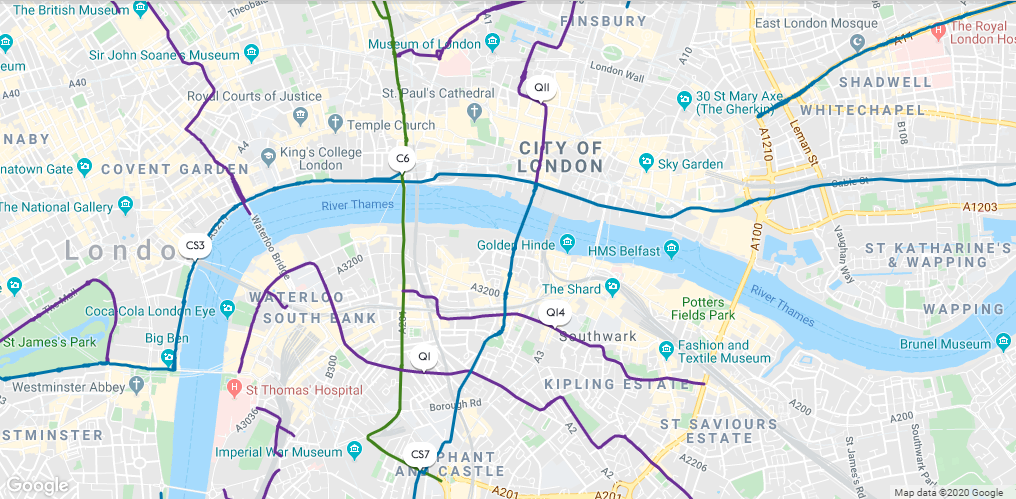Us&Co Blog
5 Tips For Commuting By Bike In Central London
The number of commuters cycling in central London has reached an all-time high, with recent TFL data suggesting almost 1 in 4 vehicles in the capital right now is a bike. With cycle-friendly infrastructure constantly improving through the city, there’s never been a better time to join the two-wheeled revolution.

There is a strong business case for companies to encourage their employees to cycle to work…
- Cycling has an obvious health advantage over driving or taking public transport that comes through regular exercise. On average, cyclists take 15% fewer days off work than non-cyclists.
- Studies show that more physically fit employees are 4 – 15% more productive and 27% less likely to make task errors.
- Cyclists are much less likely to get held-up in bad traffic or train delays. In 2018 alone, UK drivers lost an average of 178 hours due to traffic, costing the economy £7.9 billion in lost productivity.
- It is the duty of every company – big or small – to do their bit to protect the environment. Compared to driving, cycling 10km each way to work saves 1500kg of greenhouse gas emissions each year.
Here at Us&Co, we are keen advocates of any ways to enhance workplace productivity and improve the quality of life of our workspace members. At our central London co-working centre in Monument, we provide dedicated and secure bike storage spaces, as well as having on-site shower facilities that our members can use to freshen up.
Based on our own experiences of helping make cycling to work as stress-free as possible, we have put together our top tips for commuting by bike in central London.
1. Take the back roads
One of the often-cited downsides of cycling in London is how busy the roads can get – especially at key commuting times. London is home to the most congested road in the UK: the road stretching through Kingsway/Strand/Fleet Street/Cannon Street. For many would-be cycling commuters, the perils of travelling through rush hour traffic alongside countless cars, vans and buses can be enough to make them opt for a car or train instead.
There are alternatives, though. The trick is to plan your route away from the busiest roads. London’s Cycle Superhighways, for example, are a simple way to speed through the city on dedicated bike paths. Similarly, TFL’s Quietways have become an integral part of the London cycle network. Both have recently been incorporated into this London cycle map, which is a must-see for the savvy London cycler.

2. Buying cycling equipment
Even if you commute to work by bike just once or twice a week, investing in high-quality cycling equipment is crucial. A comfortable, lightweight, strong cycle bag keeps your belongings secure. Bringing a change of clothes and attaching mudguards to the bike will help prevent your smart work attire from getting damaged. Most importantly of all, bright lights, reflective clothing, and a sturdy helmet are absolute musts to help keep you safe on the roads.
3. Breathe easy
It is no secret that air pollution is a serious problem in London. Oxford Street, for example, is the most polluted square-mile area in the entirety of Europe. Many regular urban cyclists, therefore, use protective masks, which include filters that keep out particulate matter and gaseous pollutants from the air you breathe.
Even if you don’t have a protective cycling mask, it’s still not worth worrying too much about any potentially negative health impacts. This King’s College Study shows cyclists would need to keep going for 10 hours a day through central London before the negative air damage outweighed the positive exercise benefit of cycling, so rest assured that commuting by bike is benefiting your health.
4. Store your bike safely
Bikes are an easy target for thieves in London. In 2018, a total of 21,745 bikes were reported stolen in London. If your office doesn’t offer dedicated, off-street bike storage, you need to think carefully about how and where to lock up your bike. The ideal scenario is chaining it up somewhere you can see. If that’s not possible, somewhere public where passers-by would notice a thief with bolt cutters. Also, keep an eye out for CCTV cameras, as they can be a great deterrent for criminals.
It is advisable for every bike-owner to register your bike (for free!). Bikeregister.com is the UK’s leading online bicycle registration initiative that is aimed at reducing bicycle theft.
5. Get your bike checked
We recommend that you get a ‘health check’ for your bike every year to make sure everything’s in good working order. In London, there are loads of opportunities to get this done for free. The police, Halfords and Lunar Cycles (to name just a few) all offer bike safety checks and services.
Interested in co-working from a cycle-friendly workspace?
Interested in learning more about Us&Co? Us&Co offer professional co-working (hot desks, fixed desks, private offices, meeting rooms and event venue hire) in London and Dublin. We pride ourselves on creating a working atmosphere in which growing businesses, SMEs and individuals can thrive and grow.
Come look around our centres by booking a tour here.
Get in touch with the Us&Co team today:
London Monument co-working space, 7 Harp Lane
Phone us: 02030313535
London Stratford co-working space, 11 Burford Road (newly opened)
Phone us: 020 3031 3535


